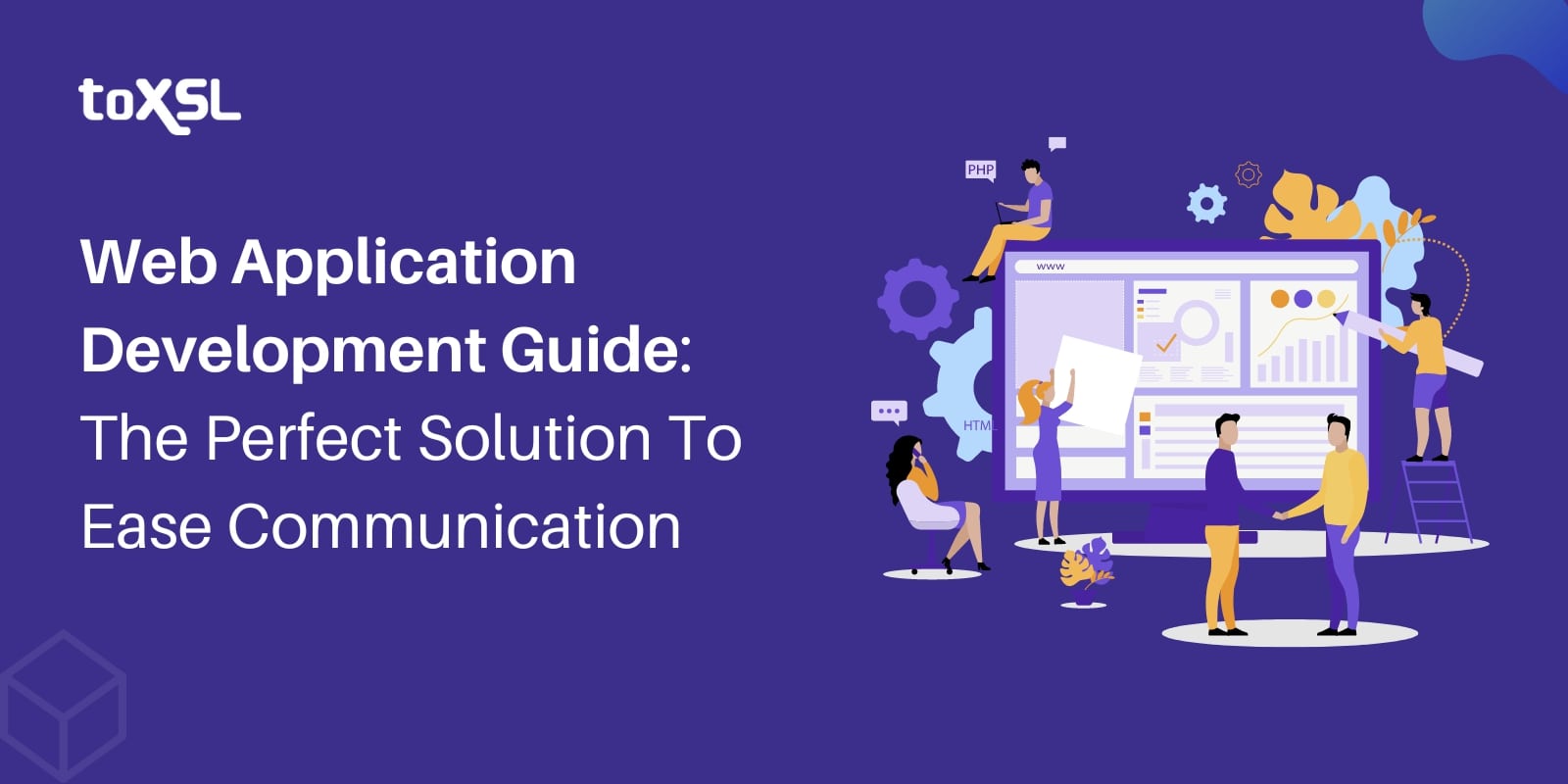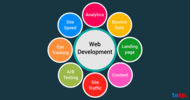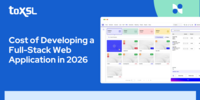- Oct 16, 2025
Share this post on:

All the web pages in the traditional times used to be static with lesser images and videos on them. However, with the rising customer expectations, it became a necessity for businesses to deliver more interactive and faster web applications.
As per research, 52% of the customers say that a bad mobile experience makes them less likely to engage with the company, and they prefer to leave. From delivering the right software solutions to meeting all their dynamic needs, these applications allow the audiences to boost their revenue and enhance their business credibility.
These applications are known to meet the diverse requirements of your business, and here is a blog that focuses on discussing the different types of web applications, the development process, and the cost of developing such applications.
What exactly are Web Apps?
Web applications are one of the most interactive applications and allow users to access them from a browser, one of the crucial benefits.
Web applications have front-end and back-end development technologies, are similar to websites, and share similar characteristics. The front-end web applications use JavaScript, CSS, and HTML. And on the back end, it uses the same server-side languages that build websites, like Ruby and Python.
Google Analytics and Mailchimp are a few examples of web applications. The applications do not need to be downloaded and can work well on browsers like Firefox, Google Chrome, or Safari. The web application generally consists of 3 layers of web apps, and that includes
- A Web browser
- Web application server
- Database Server
These platforms turn out to be the most dominating form of mobile applications and thanks to the innovative technologies that make it possible.
Types of Web Applications you should know:
Depending on the goals and objectives you want your business to cater to, it can be categorized into the different categories as follows.
1. Static Web Applications
In a static web application, content is directly displayed to the end user’s browser. Static web applications are built on HTML and CSS and do not involve interaction between the user and server. These are simple and easy to use. However, whenever you want to modify the information on the static web apps, you must refresh the page every time to see the changes.
2. Dynamic Web Applications
These are web applications that interact with clients and are developed using server-side programming to generate real-time data. It has different interactive elements that make easier user engagement.
Dynamic web applications are more complex and use a content management system for updates and modifications. One of the most popular examples includes Netflix.
3. eCommerce Web Applications
It is a web application in the form of an e-commerce store that helps promote buying and selling. Retail e-commerce has seen robust growth and is expected to reach 5.4 trillion dollars by 2022. The web application must have key features and functionalities, including payment gateway integration, admin and other panels, transaction integration, and more.
If you are willing to establish your e-commerce business, we are the best and leading choice for you and help you attract the right customers.
4. CMS Web Applications
When it is to web application development, you must update your content regularly, and therefore it becomes vital to implement the right content management system. CMS is a popular choice for its usage in personal blogs, media sources, and others. A few popular content management systems are WordPress and Drupal.
5. Single/Multi-Page Application
Single Page Application is a dynamic app that helps with improved routing and navigation. Here, the user request and responses are more effective and faster than the conventional web apps.
Multi-Page application has different pages and reloads the entire page from the server when the user navigates to a different page. These apps have no page limits and offer complete details about products and services.
6. Progressive Web Apps (PWA)
Progressive Web Applications are popular web applications having responsive designs and cross-browser compatibility. It can work in both offline and online mode and uses the latest browser APIs and progressive enhancement methods for a native mobile experience.
Progressive Web Applications are known to enhance the speed of web applications, so even during slow connectivity, you keep the work going.
How does the Web Application work?
Web applications can be accessed over a network, and there is no need to download them. Users can simply open any browser and access it. Here is how a typical web application works.
1. The user will generate a request to the server, either via a web browser or the application’s user interface.
2. The web server will take up the request from the browser.
3. Server will set up instructions that direct the application server to process the request.
4. App server will perform the appropriate and requested tasks to generate results.
5. The web server will show the requested information on the screen of the user.
Web Application Development Process
You must be wondering how to develop a web application from scratch. You must understand the entire flow of web app development that will help you develop the app seamlessly and gain insights into the entire process.
1. Looking out for the challenges and resolve
If you plan to build a web application, the most common challenge businesses face is the target audiences. A web application if not offer any value to businesses, ensure you do not invest your time and money. Therefore, ensure to develop a web application that is scalable and benefits your business and users.
2. In-depth Competitor Research
To achieve long-term success, you must know what your competitors are performing, their strategies, strengths, and weaknesses. In-depth research is a way that improves your app usage, and you can integrate the advanced features that are bringing more traffic to your competitor’s app.
3. Finalizing the feature Set
You must be able to determine the set of functionalities that your app will offer. Businesses must prioritize first the crucial features that are required in the early step.
Some businesses with a minimal budget may plan to choose an MVP option that offers them affordable solutions. MVP refers to a minimal viable product that helps determine the functionalities your app will offer. It allows you to launch your application with enough features and offers cost-effectiveness!
4. Hire the Right team of developers
For developing a web application, you must hire a team of developers well-reputed in the industry. An experienced organization will cater to your needs and offers the best development solutions on time. You can check for the client’s feedback, experience, cost, and more that will help you hire the right team of developers.
5. Launch your Web App
Now it’s time for the launch! Before publishing your web application, buy a domain with reliable hosting to choose from.
Web Applications vs. Websites
Web applications are dynamic and help in more user engagement. They require authentication and need precompilation before they are deployed. Functions in web applications are higher and more complex. Integrating with other software in the case of web applications is a complex process.
However, a website simply has static content, and this is one way, thatwhichns it does not allow user interaction when we talk about websites. Website function is simple as compared to web apps and does not need to be pre-compiled.
Web Applications vs. Mobile Apps
Mobile applications are for mobile gadgets and are suited well for platforms like Android, iOS, or cross-platform operating systems. It means that mobile applications work effectively on smartphones. Apps can function even when you are in offline mode.
Whereas web applications function only when you are connected to the Internet. A web application functions in real-time and with adequate internal storage.
Benefits that come along with Web App Development
Web application development has an array of business benefits for the users which makes it the most preferred choice. Here are the crucial benefits you should know.
1. Speed and Cost
Developing a web application is a much faster and more cost-efficient process rather than going for native app development. Therefore, if you are into the business and looking forward to accelerated process development and marketing it instantly, web app development is the ultimate choice.
2. It has the cross-platform capability
Web applications offer ease and can be run on any operating system. As it offers cross-platform capability, it can be easily adapted to Android, iOS, and other cross-platforms. With a help of a browser only, you can run it on different operating systems.
3. Customization is easy
Web applications offer a plethora of benefits, and customization is one of them. It offers tailored features to the users and can then be accessed by the users via a browser and a stable internet connection. A customized web application reduces cost and unnecessary expenses and improves your brand awareness while helping you gain a competitive edge.
4. Reduced Operating cost
Web-based applications do not require any maintenance and support. And therefore offers you the best opportunity to cut down costs and eliminate expenses. Whether it is the purchase of hardware, device updates, or other things, there is a reduced operating cost with web app development.
5. Enhanced Security
Web applications stores all your information remotely, so even if your system faces data breaches, there is no data loss as it is secured on your server. Web applications are deployed on dedicated servers and are monitored constantly.
6. Easily Accessible
In the case of web app development, users do not need to download the application on their mobile phones. A URL is enough that will make the web apps easily accessible on any device.
Also Read: Boosting Your eCommerce Conversion Rate With The Customer Journey Mapping In 2022
Cost Estimation: Web App Development
Budget is another important factor businesses consider highly crucial. It drives the complexity and personalization of any web application.
Cost estimation helps businesses identify their goals, and here are the factors that affect the cost.
- The complexity of the project
- Geographical Location of the service provider
- Engagement models
- Technical Specifications
- Full-Fledged or MVP model
These are a few factors developers take into account. However, on an estimate, the cost of developing a web application falls somewhere between $20k to $60k.
Winding-up!
Web applications are in flux and evolving faster than ever. Web app development offers a competitive edge and is a mandate for businesses to lead the digital space.
The development scope for the Web application completely depends on the business requirements and objectives. Customers should be able to leverage the best of the benefits, a better user experience, and ultimately higher user attraction.
And for the same, the organizations need to choose the most reliable partner who is better able to understand the requirements and offer you goal-oriented solutions.
Well, to help you stay competitive, ToXSL offers Leading web app development company and turns your dream project into a reality!
Contact our team today and hire a team of qualified experts and developers to get your project completed.












